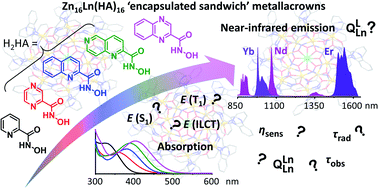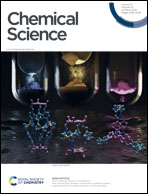Tuning the photophysical properties of lanthanide(iii)/zinc(ii) ‘encapsulated sandwich’ metallacrowns emitting in the near-infrared range†
Abstract
A family of Zn16Ln(HA)16 metallacrowns (MCs; Ln = YbIII, ErIII, and NdIII; HA = picoline- (picHA2−), pyrazine- (pyzHA2−), and quinaldine- (quinHA2−) hydroximates) with an ‘encapsulated sandwich’ structure possesses outstanding luminescence properties in the near-infrared (NIR) and suitability for cell imaging. Here, to decipher which parameters affect their functional and photophysical properties and how the nature of the hydroximate ligands can allow their fine tuning, we have completed this Zn16Ln(HA)16 family by synthesizing MCs with two new ligands, naphthyridine- (napHA2−) and quinoxaline- (quinoHA2−) hydroximates. Zn16Ln(napHA)16 and Zn16Ln(quinoHA)16 exhibit absorption bands extended into the visible range and efficiently sensitize the NIR emissions of YbIII, ErIII, and NdIII upon excitation up to 630 nm. The energies of the lowest singlet (S1), triplet (T1) and intra-ligand charge transfer (ILCT) states have been determined. LnIII-centered total (QLLn) and intrinsic (QLnLn) quantum yields, sensitization efficiencies (ηsens), observed (τobs) and radiative (τrad) luminescence lifetimes have been recorded and analyzed in the solid state and in CH3OH and CD3OD solutions for all Zn16Ln(HA)16. We found that, within the Zn16Ln(HA)16 family, τrad values are not constant for a particular LnIII. The close in energy positions of T1 and ILCT states in Zn16Ln(picHA)16 and Zn16Ln(quinHA)16 are preferred for the sensitization of LnIII NIR emission and ηsens values reach 100% for NdIII. Finally, the highest values of QLLn are observed for Zn16Ln(quinHA)16 in the solid state or in CD3OD solutions. With these data at hand, we are now capable of creating MCs with desired properties suitable for NIR optical imaging.

- This article is part of the themed collection: 2022 Chemical Science HOT Article Collection


 Please wait while we load your content...
Please wait while we load your content...